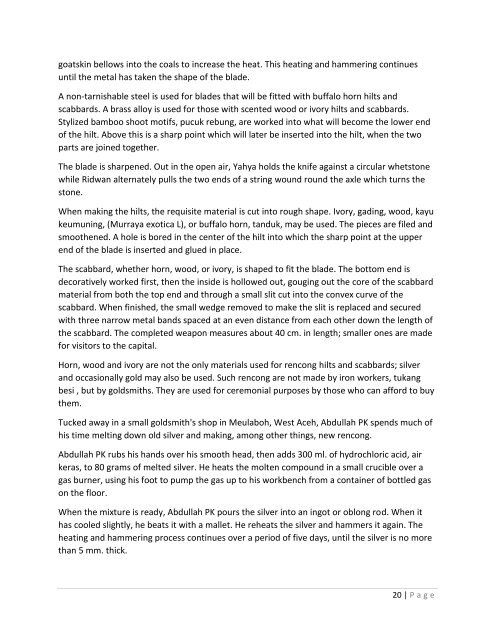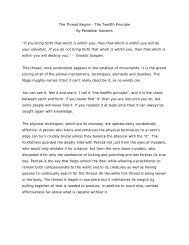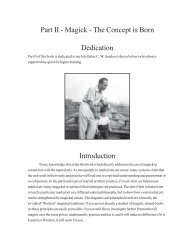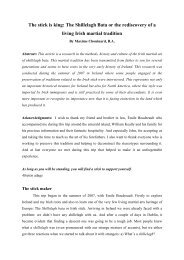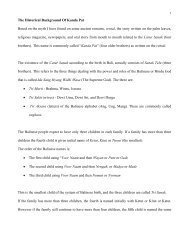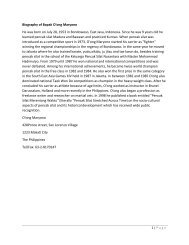The Myth of Maempo Cimande - Pukulan Cimande Pusaka
The Myth of Maempo Cimande - Pukulan Cimande Pusaka
The Myth of Maempo Cimande - Pukulan Cimande Pusaka
Create successful ePaper yourself
Turn your PDF publications into a flip-book with our unique Google optimized e-Paper software.
goatskin bellows into the coals to increase the heat. This heating and hammering continues<br />
until the metal has taken the shape <strong>of</strong> the blade.<br />
A non-tarnishable steel is used for blades that will be fitted with buffalo horn hilts and<br />
scabbards. A brass alloy is used for those with scented wood or ivory hilts and scabbards.<br />
Stylized bamboo shoot motifs, pucuk rebung, are worked into what will become the lower end<br />
<strong>of</strong> the hilt. Above this is a sharp point which will later be inserted into the hilt, when the two<br />
parts are joined together.<br />
<strong>The</strong> blade is sharpened. Out in the open air, Yahya holds the knife against a circular whetstone<br />
while Ridwan alternately pulls the two ends <strong>of</strong> a string wound round the axle which turns the<br />
stone.<br />
When making the hilts, the requisite material is cut into rough shape. Ivory, gading, wood, kayu<br />
keumuning, (Murraya exotica L), or buffalo horn, tanduk, may be used. <strong>The</strong> pieces are filed and<br />
smoothened. A hole is bored in the center <strong>of</strong> the hilt into which the sharp point at the upper<br />
end <strong>of</strong> the blade is inserted and glued in place.<br />
<strong>The</strong> scabbard, whether horn, wood, or ivory, is shaped to fit the blade. <strong>The</strong> bottom end is<br />
decoratively worked first, then the inside is hollowed out, gouging out the core <strong>of</strong> the scabbard<br />
material from both the top end and through a small slit cut into the convex curve <strong>of</strong> the<br />
scabbard. When finished, the small wedge removed to make the slit is replaced and secured<br />
with three narrow metal bands spaced at an even distance from each other down the length <strong>of</strong><br />
the scabbard. <strong>The</strong> completed weapon measures about 40 cm. in length; smaller ones are made<br />
for visitors to the capital.<br />
Horn, wood and ivory are not the only materials used for rencong hilts and scabbards; silver<br />
and occasionally gold may also be used. Such rencong are not made by iron workers, tukang<br />
besi , but by goldsmiths. <strong>The</strong>y are used for ceremonial purposes by those who can afford to buy<br />
them.<br />
Tucked away in a small goldsmith's shop in Meulaboh, West Aceh, Abdullah PK spends much <strong>of</strong><br />
his time melting down old silver and making, among other things, new rencong.<br />
Abdullah PK rubs his hands over his smooth head, then adds 300 ml. <strong>of</strong> hydrochloric acid, air<br />
keras, to 80 grams <strong>of</strong> melted silver. He heats the molten compound in a small crucible over a<br />
gas burner, using his foot to pump the gas up to his workbench from a container <strong>of</strong> bottled gas<br />
on the floor.<br />
When the mixture is ready, Abdullah PK pours the silver into an ingot or oblong rod. When it<br />
has cooled slightly, he beats it with a mallet. He reheats the silver and hammers it again. <strong>The</strong><br />
heating and hammering process continues over a period <strong>of</strong> five days, until the silver is no more<br />
than 5 mm. thick.<br />
20 | P a g e


